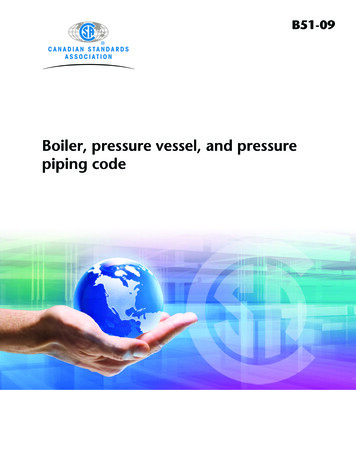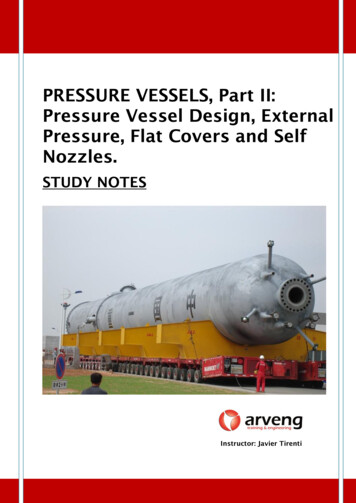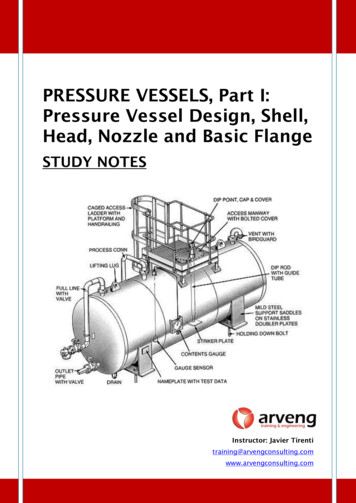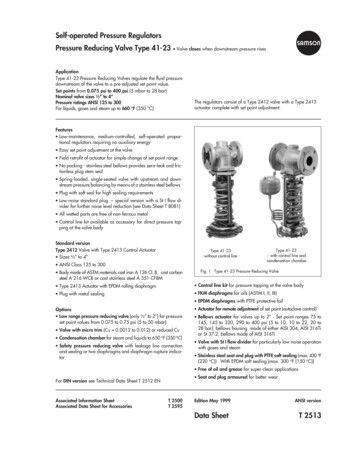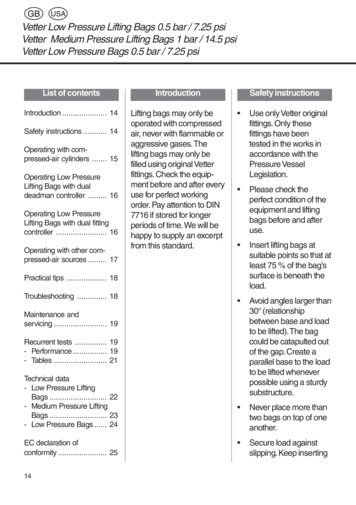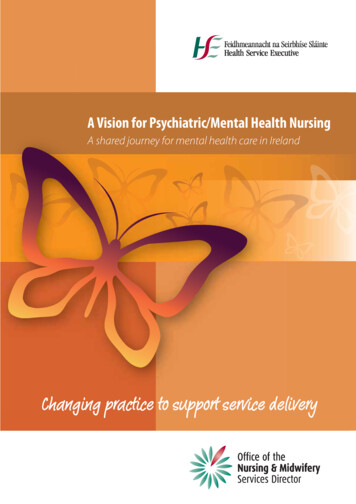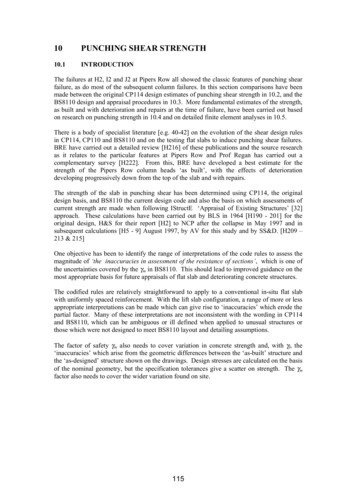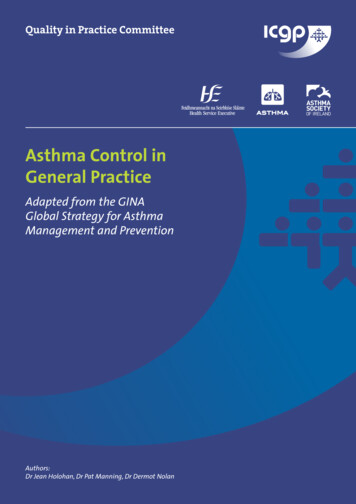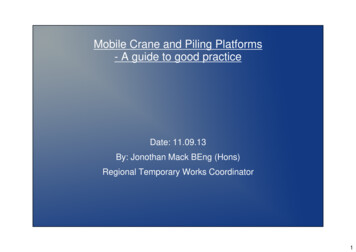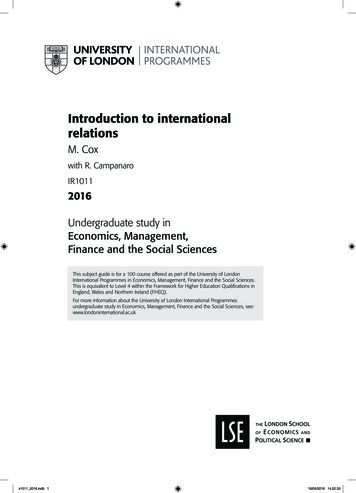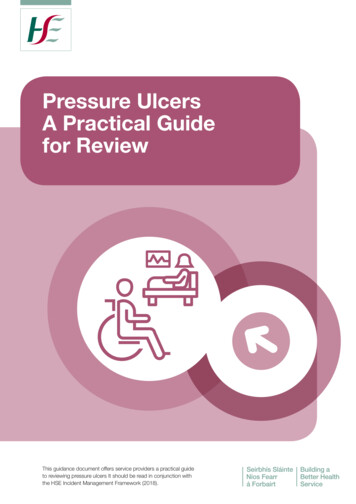
Transcription
Pressure UlcersA Practical Guidefor ReviewThis guidance document offers service providers a practical guideto reviewing pressure ulcers It should be read in conjunction withthe HSE Incident Management Framework (2018).
TABLE OF CONTENTSTABLE OF CONTENTSIntroduction . 22. 3Aim .Introduction23Aim.Scope. 33Abbreviationsused in this Guide . 33Scope.Abbreviationsused in this Guide . 344Definitions .Pressure UlcerStaging System (HSE 2018) . 545Definitions.PressureManagementIncidentPressure. 566Ulcer Staging Process:System (HSE2018)Ulcers.IncidentManagementProcess: PressureUlcers.Step 1: PressureUlcer Prevention– includingPressureUlcer Risk Assessment . 6772: PressureIdentificationActions Required.Step 1:UlcerandPrevention– includingPressure Ulcer Risk Assessment . 878Step 2:andandActionsRequired. 9893: IdentificationInitial ReportingNotification.Step 4:and andCategorisationthe Incident . 11113: AssessmentInitial ReportingNotificationof.9Step 4:5: AssessmentReview and andAnalysis.18Categorisationof the Incident . 1811Step 6:5: ImprovementReview and Analysis.Planningand Monitoring . 182020References.21Step6: ImprovementPlanning and Monitoring . 2120Appendix1.SSKINbundle22HSE2018Pressure Ulcer Category/Staging System Recommendation.210References2.HSE 2018 ndation.230Appendix 2.3 PreliminaryAssessmentAssist Review Decision.1Appendix 3to AssistReview.Decision Making .2414.PreliminaryConductingAssessmenta Concise ReviewGuidance8Appendix 4.Conductinga Concise85. PressureUlcerReviewReviewReportGuidanceTemplate. 16315. MembershipPressure UlcerofReviewReportUlcerTemplate.39Appendix 6.the PressureReviewGuide Group. 1623Appendix 6. Membership of the Pressure Ulcer Review Guide Group. 23461
IntroductionA pressure ulcer is a “localised injury to the skin and/or underlying tissue usually over a bonyprominence, as a result of pressure, or pressure in combination with shear”1. These wounds occurfrequently among individuals who have difficulty moving, or cannot reposition themselves, such asthe frail elderly, individuals undergoing surgery, or individuals with spinal cord injury. However, anyservice user, of any age, could develop a pressure ulcer if they are exposed to prolonged, unrelievedpressure and shear forces2. Pressure ulcers are common, for example, within acute and long staysettings in Ireland, mean pressure ulcer prevalence is estimated at 16%, whereas mean incidence isestimated at 11%3. These figures reflect the international data where a mean prevalence of 20.9%has been reported in the acute setting and 11.7% in the long stay setting3. Internationally, meanincidence within acute care is reported at 18% and within long stay is reported at 6.6%3.Pressure ulcers pose significant physical and psychological challenges for individuals, impactingnegatively on activities of daily living with severe, intractable pain, being one of the most commonand difficult aspects of living with a pressure ulcer4-7. From a financial perspective, pressure ulcersnot only impact on the individual, but also on health services and by proxy, society as a whole. Datasuggest that the management of pressure ulcers absorbs almost 4% of health care budgets inEurope8. From an Irish perspective, a recent study9 estimated the financial burden of wounds ingeneral, at 6% (95%CI’s: 4% to 8%) of total public health expenditure in 2013; given the highprevalence and incidence of pressure ulcers, it is likely that these wounds significantly contribute tothis expenditure. Most pressure ulcers can be avoided, providing individuals at risk are correctlyidentified and appropriate measures are put into place to combat risk. Despite this, thedevelopment of pressure ulcers often arises because there has been a failure to implementappropriate prevention strategies. Annually, in the UK, of the 6 most common adverse events, thegreatest burden was exerted by pressure ulcers equating to 13,780 healthy life years lost10.Worryingly, individuals can die as a direct result of a pressure ulcer, indeed, global mortality directlyattributable to pressure ulcers has increased by 32.7% from 2000- 201011.A proportionate and responsive review of all stages of pressure ulcers when identified can assist indetecting factors that caused and contributed to the development of the pressure ulcer. Suchinformation can then be used to implement improvement initiatives that could prevent subsequenttissue damage to the individual and prevent other service users in developing a pressure ulcer. Italso gives assurance that appropriate governance structures and processes are in place, as requiredby the HSE Incident Management Framework (2018).The Incident Management Framework describes the following six steps in the management ofincidents: Prevention through supporting a culture where safety is a priority Identification and immediate actions required (for service users directly affected and tominimise risk of further harm to others) Initial reporting and notification Assessment and categorisation Review and analysis Improvement planning and monitoring2
AimThe aim of this document is to give services a practical guide to reviewing pressure ulcers whichaligns to the six steps described in the HSE Incident Management Framework 2018 (see Figure 1)ScopeThe scope of this document relates to service users within HSE and HSE-funded acute hospitals,mental health and social care inpatient/residential facilities and the community. This documentshould be read in conjunction with the HSE Incident Management Framework 2018.Abbreviations used in this IAQPSSAOSIMTSRETVNCommunity Healthcare OrganisationEuropean Pressure Ulcer Advisory PanelHealth Information and Quality AuthorityHealth and Social Care ProfessionalHealth Service ExecutiveLocal Accountable Officer e.g. line managerMoisture Associated Skin DamageMultidisciplinary TeamNational Incident Report FormNational Incident Management SystemNational Pressure Ulcer Advisory PanelPan Pacific Pressure Injury AllianceQuality & Patient SafetySenior Accountable Officer e.g. Head of Service or Hospital ManagerSerious Incident Management TeamSerious Reportable EventTissue Viability Nurse3
DefinitionsPressure Ulcer: “A pressure ulcer is localised injury to the skin and/or underlying tissue usually overa bony prominence, as a result of pressure, or pressure in combination with shear”.(NPUAP/EPUAP/PPPIA, 2014).This guideline will use the UK Department of Health definitions of the terms Avoidable andUnavoidable Pressure Ulcers. This is a modified version of Avoidable and Unavoidable PressureUlcers definitions from the Centre for Medicare and Medicaid (CMS) 2004, adapted to keep in linewith UK policy terminology. The modified definitions are: Avoidable Pressure Ulcer: “Avoidable means that the service user receiving care developeda pressure ulcer and the provider of care did not do one or more of the following: evaluatethe service user’s clinical condition and pressure ulcer risk factors; plan and implementinterventions that are consistent with the service users’ needs and goals, and recognisedstandards of practice; monitor and evaluate the impact of the interventions; or revise theinterventions as appropriate.” Unavoidable Pressure Ulcer: “Unavoidable means that the service user receiving caredeveloped a pressure ulcer even though the provider of the care had evaluated the serviceuser’s clinical condition and pressure ulcer risk factors; planned and implementedinterventions that are consistent with the service user’s needs and goals; and recognisedstandards of practice; monitored and evaluated the impact of the interventions; and revisedthe approaches as appropriate; or the individual service user refused to adhere toprevention strategies in spite of education of the consequences of non-adherence”Moisture-Associated Skin Damage (MASD): “inflammation and erosion of the skin caused byprolonged exposure to various sources of moisture, including urine or stool, perspiration, woundexudate, mucus or saliva, and their contents .characterised by inflammation of the skin occurringwith or without erosion or secondary cutaneous infection.” (Gray et al., 2011, p233)4
Pressure Ulcer Staging System (HSE 2018)Stage I: Intact skin with non – blanchable redness of a localised area usually over a bonyprominence. Discolouration of the skin, warmth, oedema, hardness or pain may also be present.Darkly pigmented skin may not have visible blanching. The area may be painful, firm, soft, warmer orcooler as compared to adjacent skin (EPUAP 2009).Stage II: Partial thickness skin loss of dermis presenting as a shallow ulcer with a red pink woundbed, without slough. May present as an intact or open/ ruptured serum filled blister filled withserous or sero- sanguineous fluid. Presents as a shiny or dry shallow ulcer without slough or bruising(EPUAP 2009).Stage III: Full thickness skin loss. Subcutaneous fat may be visible but bone, tendon or muscles arenot exposed. Slough may be present but does not obscure the depth of tissue loss. The stage mayinclude undermining or tunnelling (EPUAP 2009).Stage IV: Full thickness tissue loss with exposed bone, tendon or muscle. Slough or eschar may bepresent. This stage often includes undermining and tunnelling. Exposed bone / muscle is visible ordirectly palpable (EPUAP 2009).Suspected deep pressure and shear induced tissue damage, depth unknownIn service users with non-blanchable redness and purple/maroon discoloration of intact skincombined with a history of prolonged, unrelieved pressure/shear, this skin change may be anindication of emerging, more severe pressure ulceration i.e. an emerging Stage 111 or 1V PressureUlcer Clear recording of the exact nature of the visible skin changes, including recording of the riskthat these changes may be an indication of emerging more severe pressure ulceration, should bedocumented in the service user’s health record. These observations should be recorded in tandemwith information pertaining to the service user’s history of prolonged, unrelieved pressure/shear.It is estimated that it could take 3-10 days from the initial insult causing the damage, to become aStage 111 or 1V Pressure Ulcer1See Appendix 2 for illustration of the HSE 2018 Pressure Ulcer Category/Staging SystemRecommendation.1HSE National Wound Management Guidelines (2018)5
Incident Management Process
A Practical Guide for Review This guidance document offers service providers a practical guide to reviewing pressure ulcers It should be read in conjunction
